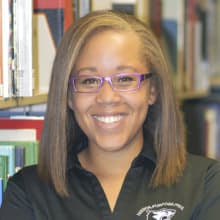I usually introduce myself as a special education teacher; but first and foremost, I need you to know that I am a proud step team coach. As coach to Apex Friendship’s Top Notch Steppers, I have the pleasure of guiding a diverse group of young people in the discovery of their cultural and social identities as they unite to create the dopest rhythms and slickest steps.
For one of my favorite steps, the junior and senior captains shout out a call and the team responds with a shout or step. With uplifted spirit and joy, they bellow…
“In the early 1900s, the tradition of step was rooted in Black culture…”
Stepping is a rich tradition which is rooted in African and Black communities that combines stomps, claps, and spoken word. In the early 1900s, the art and culture of step was pushed to the forefront by historically Black fraternities and sororities. Now, step is seen and heard in schools, churches, and communities to demonstrate allegiance to a shared identity in Black and Brown culture.
Black culture is found in isolated pockets in my school where the students and staff are predominantly white. Students and staff have to find safe spaces where Blackness and Black culture are celebrated and embraced. For me, it means accepting the incredible responsibility of supporting students of color on the step team and organizing members of our Black Student Alliance (BSA).
“Step is a mixture of our step…”
Eighty percent of North Carolina public school teachers are white, according to data from the Department of Public Instruction, while less than fifty percent of students are white. That means many minority students, who make up almost half of the state’s public school enrollment, step into classrooms and miss out on the benefits of having teachers who look like them. Several weeks ago, our team — swagged out in all black — stepped in the cafeteria surrounded by a sea of white faces. They killed it! But their flash mob performance got me thinking about how these students step into classrooms full of mostly white peers and teachers.
Being a person of color can feel isolating because you are surrounded by whiteness. Being a student of color can lead to a longing to connect to a strong, Black teacher in a room where your Blackness is seen and celebrated, encouraged.
“Spoken word… Alright!”
As minorities at predominantly white institutions (PWIs), we must speak our truth out loud. In my classroom and at step practice, I speak my truth by sharing my personal experiences as a former student in a PWI in a small country town. After my students endure microaggressions at school, I share what it was like to endure racial slurs from peers throughout my time in school. I speak my truth in front of white colleagues who may never know what it is like to have your equity initiatives brushed off as the current ed-trend. But I continue to speak truth to power to lift the voices of marginalized groups, like students and teachers of color in PWIs.
“And claps…” *clap*clap*clap*
Those microaggressions I mentioned? They happen when Professional Learning Team (PLT) members turn to you for diverse book suggestions or your co-teacher asks you to read a poem by an author of color. They happen when the step team does not feel like their voices are being fully represented in the community at-large. So sometimes, we have to clap back.
My professional clapbacks include incorporating anti-racist pedagogy in my classroom practices and championing equity work in my school and district. My step team members use their voices to start Twitter campaigns drawing attention to Black history and issues affecting their school and community. They organize community halftime performances with the local police department emphasizing the importance of community policing. Unfortunately, as people of color we will continue to endure microaggressions that serve to make us feel less than, especially when live in PWIs; however, we will continue to clap back and make it known that we are not complicit in our own oppression.
“And if you got a problem wit it, then you can step back!”
Although it is not my sole duty as one of the few teachers of color at my school to seek relationships with students of color, I feel a great deal of responsibility to create sacred spaces for students of color to feel secure, welcomed, and celebrated. For people of color in predominantly white institutions, those safe spaces can be hard to to come by.
A Black student once asked me, “Why do we even need a BSA? Why can’t we just be who we are, wherever we are?”
I ask myself that second question far too often. Until we can be who we are, wherever we are, we’ll continue to step. For the culture.



